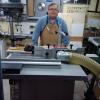I know there are plenty of theories (and lots of science) on dust collection, but in parallel to my own research I wanted to check the wisdom of the group here. I have today a Delta AP400 Shopmaster 1hp dust collector that I have used for about 7 years with good success, although it is a one connnection at a time tool. I run through a home made separator (haven't installed the baffle yet) and overall it collects most of the dust off of the tool, but I still deal with a lot of dust that is not picked up. I am considering upgrading with Jet starting their 15% off sale next week (a Rockler gift card for Christmas has something to do with this as well).
At what point am I truly upgrading ? If I buy an equivalent 1hp Jet unit that moves 650cfm am I really upgrading or am I better off not making the purchase ? Do I need to step up to a 1.5hp unit ? of course it is better, but money is never not an object. Of course I know I can also go the Craigslist route and have no qualms about it, but if I could get a good upgrade out of the Jet sale and sell my Delta, that might be a preferred route.
Any help or advice would be appreciated.
Thanks
Todd in Atlanta




 Reply With Quote
Reply With Quote
